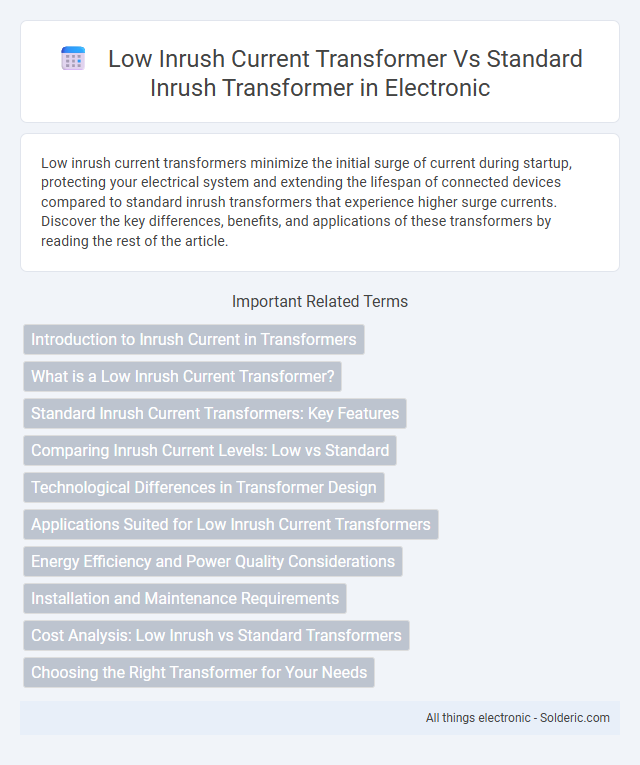Low inrush current transformers minimize the initial surge of current during startup, protecting your electrical system and extending the lifespan of connected devices compared to standard inrush transformers that experience higher surge currents. Discover the key differences, benefits, and applications of these transformers by reading the rest of the article.
Comparison Table
| Feature | Low Inrush Current Transformer | Standard Inrush Current Transformer |
|---|---|---|
| Inrush Current | Significantly reduced peak current | High peak current at energization |
| Core Design | Specialized core with optimized magnetic properties | Conventional magnetic core |
| Transformer Life | Extended due to lower mechanical and thermal stress | Standard life expectancy |
| Energy Losses | Lower transient losses during startup | Higher transient losses |
| Cost | Higher initial cost due to advanced design | Lower initial cost |
| Applications | Critical systems, sensitive equipment, power quality sensitive areas | General power distribution and standard industrial use |
| Size & Weight | Often larger/heavier due to enhanced core design | Standard size and weight |
| Magnetizing Current | Lower peak magnetizing current | Higher peak magnetizing current |
Introduction to Inrush Current in Transformers
Inrush current in transformers refers to the initial surge of current experienced when the transformer is energized, often reaching 5 to 10 times the normal operating current. Low inrush current transformers are designed with special core materials and winding configurations to minimize this surge, reducing stress on electrical components and improving system longevity. Your choice of a low inrush current transformer can enhance system stability by limiting voltage dips and preventing nuisance tripping in sensitive circuits compared to standard inrush transformers.
What is a Low Inrush Current Transformer?
A Low Inrush Current Transformer is designed to minimize the initial surge of current when energized, reducing mechanical stress and voltage dips in electrical systems. This type of transformer typically incorporates special core materials and winding techniques that limit the magnetic flux, preventing the high transient currents common in standard inrush transformers. By controlling inrush current, these transformers enhance system reliability, protect sensitive equipment, and extend the lifespan of electrical components.
Standard Inrush Current Transformers: Key Features
Standard inrush current transformers exhibit a high initial surge of current when energized, which can be several times greater than the rated current, leading to potential mechanical stress and thermal challenges. These transformers typically lack specialized design elements like pre-magnetization or inrush mitigation cores, resulting in significant magnetizing inrush current. Their construction involves conventional core materials and winding configurations without added features to reduce transient current spikes during startup.
Comparing Inrush Current Levels: Low vs Standard
Low inrush current transformers generate significantly reduced transient currents during energization compared to standard inrush transformers, minimizing voltage dips and mechanical stress. Your electrical system benefits from enhanced longevity and reliability due to the lower magnetic saturation and mitigated thermal stress in low inrush designs. This reduction in peak current improves overall system stability and reduces the risk of nuisance tripping in protective devices.
Technological Differences in Transformer Design
Low inrush current transformers incorporate advanced winding techniques, such as distributed and optimized coil arrangements, to reduce magnetic flux surges during energization, whereas standard inrush transformers use conventional winding structures. Core materials in low inrush transformers often feature high-grade silicon steel with improved magnetic properties and precisely engineered laminations to minimize initial magnetizing current spikes. Your choice of transformer impacts system stability by mitigating transient overcurrent conditions typical in standard designs.
Applications Suited for Low Inrush Current Transformers
Low inrush current transformers are ideal for applications requiring reduced transient currents, such as sensitive electronic equipment, medical devices, and renewable energy systems, where minimizing voltage dips and electrical stress is critical. These transformers enhance the reliability of power distribution in industrial automation and data centers by preventing nuisance tripping of protective devices. Choosing low inrush current transformers helps maintain system stability and extends the lifespan of your electrical components in environments with frequent load switching.
Energy Efficiency and Power Quality Considerations
Low inrush current transformers significantly improve energy efficiency by reducing the magnetic saturation and stress on electrical components during startup, leading to lower energy losses and extended equipment lifespan. They enhance power quality by minimizing voltage dips and harmonic distortions typically caused by high inrush currents in standard transformers. Implementing low inrush current technology helps maintain stable voltage levels and protects sensitive electronic devices from power disturbances.
Installation and Maintenance Requirements
Low inrush current transformers require simplified installation processes due to reduced need for pre-inrush current limiting devices, lowering initial setup complexity. Maintenance schedules benefit from decreased thermal and mechanical stresses, resulting in extended transformer lifespan and fewer service interventions compared to standard inrush transformers. This reduction in operational strain enhances overall reliability and decreases downtime, optimizing long-term maintenance costs and resource allocation.
Cost Analysis: Low Inrush vs Standard Transformers
Low inrush current transformers typically incur higher initial costs due to specialized core designs and advanced materials that reduce startup current peaks, enhancing equipment longevity and minimizing nuisance tripping. Standard inrush transformers have lower upfront expenses but may lead to increased operational costs from frequent maintenance and potential damages caused by higher inrush currents. Evaluating total cost of ownership reveals that low inrush transformers offer long-term savings despite higher purchase prices, especially in sensitive or heavy-load applications requiring stable power delivery.
Choosing the Right Transformer for Your Needs
When selecting between a low inrush current transformer and a standard inrush transformer, consider the specific application requirements, including load sensitivity and power quality constraints. Low inrush current transformers minimize peak current spikes during startup, reducing stress on electrical components and enhancing system reliability. Standard inrush transformers, while typically more cost-effective, may cause higher current surges, which can affect sensitive equipment and circuit protection devices.
low inrush current transformer vs standard inrush transformer Infographic

 solderic.com
solderic.com